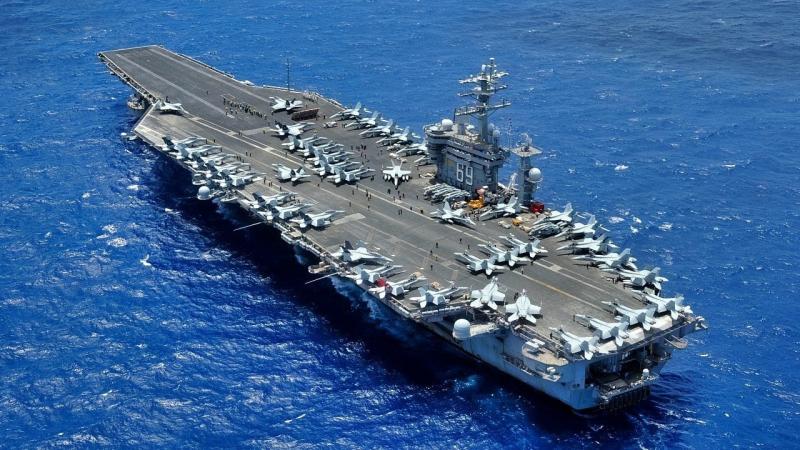Houthis Came Close to Hitting U.S. Navy Nuclear Aircraft Carrier with a Missile
By: Harrison Kass (The National Interest)



The Problem: In a close call, a Houthi missile came within 200 meters of the USS Dwight D. Eisenhower earlier this year, according to a report in CTC Sentinel. Operating in the Red Sea and surrounding regions, the carrier deployed various defenses, but this near-hit underscores growing threats from non-state actors like the Houthis.
-Armed with drones, cruise, and ballistic missiles, the Houthis, backed by Iran, have repeatedly targeted international shipping and military vessels.
-What Happens Next? The incident raises concerns over U.S. carrier vulnerabilities, suggesting that even sophisticated American supercarriers face threats from relatively low-cost missile technology.
Houthi Missile Narrowly Misses U.S. Aircraft Carrier Eisenhower
The Houthi rebels nearly hit a US aircraft carrier with a missile, new report shows. The incident, which occurred earlier it the year, but was only just reported in the October issue of CTC Sentinel (Combating Terrorism Center at West Point's monthly publication), suggests that the Houthi missile came within just 200 meters of the USS Dwight D. Eisenhower.
"By some accounts, an ASBM [anti-ship ballistic missile] or other missile arrived at a very shallow trajectory, with minimal warning, without a chance for interception, and splashing down around 200 meters [656 feet]" from the Eisenhower. In other words: it was a close call.
Attacking the Shipping Lane
The Houthis, whom Iran supports, have been attacking international shipping lanes in the Red Sea, the Bab el-Mandeb Strait, and the Gulf of Aden ever since the war between Israel and Hamas began last October. The Eisenhower, along with other US and European vessels, were sent to the region to protect civilian ships traversing through the shipping lanes.
The Eisenhower, in particular, was quite busy during the deployment, expending "155 surface-to-air missiles, 135 land-attack cruise missiles, nearly 60 air-to-air missiles and 420 air-to-surface weapons during what is called a "historic" combat deployment," Newsweek reported.
But the Eisenhower has been a target, as well. The Houthis, who have a diverse arsenal, including air, land, and sea drones, ballistic missiles, and cruise missiles, have been pushing back against the American presence in the region. The Eisenhower has relied upon its Carrier Strike Group, which includes a cruiser and destroyers, for protection. "The cruiser and destroyers, which were armed with missiles for air defense, formed a defensive layer to protect the aircraft carrier," Newsweek reported. "Meanwhile, fighter jets aboard the aircraft carrier, equipped with air-to-air missiles, can shoot down slow-flying drones and missiles." Fortunately, the Eisenhower itself is equipped with self-defense weaponry, including surface-to-air missiles and gun systems for close-in threats.
Yet, the fact that low-tech drones and missiles, in the possession of a relatively rag-tag terrorist organization, can pose a legitimate threat to a multi-billion-dollar American supercarrier should be a point of concern - and speaks to the increased relevance of non-state actors in the post-Cold War global order. The aircraft carrier is a symbol for a nation's prestige, military might, and technical prowess; that a rebel group armed with drones and missiles can threaten such a symbol perhaps transcends symbolism.
The supercarrier's vulnerability to the Houthi rebels is also likely to exacerbate concerns over naval readiness for a confrontation with China. US strategy in the Indo-Pacific, where China has become increasingly assertive, depends upon successful aircraft carrier deterrence. Yet, to keep the carrier fleet safe from China's (relative to the Houthi's) sophisticated weaponry, America's flagships may have a muted impact on any conflict.
But, frankly, the US public does not have, nor should have, the tolerance for the loss of a supercarrier. The human and fiscal toll implicit in the loss of just one supercarrier would be a shock to the conscious for a nation that has been able to engage in foreign conflict in a slow-burning, partially-committed sort of way for nearly two generations.
Harrison Kass is a defense and national security writer with over 1,000 total pieces on issues involving global affairs. An attorney, pilot, guitarist, and minor pro hockey player, Harrison joined the US Air Force as a Pilot Trainee but was medically discharged. Harrison holds a BA from Lake Forest College, a JD from the University of Oregon, and an MA from New York University. Harrison listens to Dokken.
No personal insults
No death wishes of any individual
All of NT's rules apply
PS
Calling members "trolls" or ""dishonest" will result in your comment being deleted.





The Eisenhower, in particular, was quite busy during the deployment, expending "155 surface-to-air missiles, 135 land-attack cruise missiles, nearly 60 air-to-air missiles and 420 air-to-surface weapons during what is called a "historic" combat deployment," Newsweek reported.
All in defense!
January 21st can't come fast enough.
So fucking well DO SOMETHING about it. Do you think just prodding a charging bull or an attacking grizzly bear with a stick is going to stop it? Go in and OBLITERATE those God damned Houthis before they actually SUCCEED in demolishing your holy flagship.
No, that's why we have the 2nd amendment.....
Okay, get on board with your AR-15 and wipe out those Houthis.